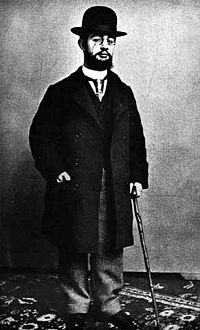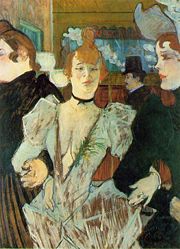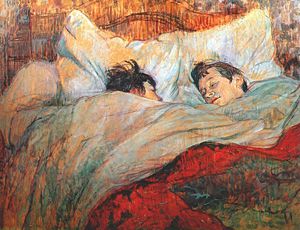Difference between revisions of "Henri de Toulouse-Lautrec" - New World Encyclopedia
Laura Brooks (talk | contribs) m (Reverted edits by Kevin Convery (); changed back to last version by David Burgess) |
|||
| Line 19: | Line 19: | ||
}} | }} | ||
| − | '''Henri de Toulouse-Lautrec''' ([[International Phonetic Alphabet|IPA]] {{IPA|/ɑ̃ʁi də tuluz lotʁɛk/}}) ([[November 24]], [[1864]] – [[September 9]], [[1901]]) was a [[France|French]] [[painter]], [[printmaker]], [[drawing|draftsman]], and illustrator, whose immersion in the decadent and theatrical life of [[fin de siècle]] [[Paris]] yielded an ''oeuvre'' of provocative images of modern life. | + | '''Henri de Toulouse-Lautrec''' ([[International Phonetic Alphabet|IPA]] {{IPA|/ɑ̃ʁi də tuluz lotʁɛk/}}) ([[November 24]], [[1864]] – [[September 9]], [[1901]]) was a [[France|French]] [[painter]], [[printmaker]], [[drawing|draftsman]], and illustrator, whose immersion in the decadent and theatrical life of [[fin de siècle]] [[Paris]] yielded an ''oeuvre'' of provocative images of modern life. Toulouse Lautrec is considered to be a post impressionist. |
==Biography== | ==Biography== | ||
Revision as of 01:45, 22 August 2007
| Henri de Toulouse-Lautrec | |
 Henri de Toulouse-Lautrec. | |
| Birth name | Henri Marie Raymond de Toulouse-Lautrec Monfa |
| Born | November 24, 1864 |
| Died | September 9, 1901 (aged 36) |
| Nationality | French |
| Field | Painter, Printmaker, draftsman, illustrator |
| Movement | Impressionism |
| Famous works | bohemian, Earthquake (cocktail), Cognac |
Henri de Toulouse-Lautrec (IPA /ɑ̃ʁi də tuluz lotʁɛk/) (November 24, 1864 – September 9, 1901) was a French painter, printmaker, draftsman, and illustrator, whose immersion in the decadent and theatrical life of fin de siècle Paris yielded an oeuvre of provocative images of modern life. Toulouse Lautrec is considered to be a post impressionist.
Biography
Youth
Henri Marie Raymond de Toulouse-Lautrec Monfa was born in Albi, Tarn in the Midi-Pyrénées Region of France, the firstborn child of Comte Alphonse and Comtesse Adèle de Toulouse-Lautrec. An aristocratic family that had recently fallen on hard times, the Toulouse-Lautrecs were still feeling the effects of the inbreeding of past generations; the Comte and Comtesse were first cousins, and Henri suffered from a number of congenital health conditions attributed to this tradition of inbreeding (see below). A younger brother was born to the family on August 28, 1867, but died the following year.
Disfiguration
At ages 13 and 14, Henri fractured both his thigh bones. The breaks did not heal properly (modern physicians attribute this to an unknown genetic disorder along the lines of osteoporosis or osteogenesis imperfecta; others speak of rickets aggravated with praecox virilism), and his legs ceased to grow, so that as an adult he was only 1.52 m/5 ft tall, having developed an adult-sized torso but retained his child-sized legs (0.70 m/27.5 in long). It has been noted that he had hypertrophied genitals.
Research supports that the artist's deformities were most likely caused by pycnodysostosis.
Physically unable to participate in most of the activities typically enjoyed by men his age, Toulouse-Lautrec immersed himself in his art. He became an important post-Impressionist painter, art nouveau illustrator, and lithographer and recorded in his works many details of the late-19th century bohemian lifestyle in Paris. Toulouse-Lautrec also contributed a number of illustrations to the magazine Le Rire during the mid-1890s.
Paris
He was declared to be "The soul of Montmartre", the Parisian quarter where he made his home. He often portrayed life at the Moulin Rouge and other Montmartre and Parisian cabaret and theaters, and, particularly, in the brothels that he frequented avidly (allegedly, he contracted syphilis from Rosa la Rouge, who lived in a brothel). He lived there for long periods among the women that adopted him wholeheartedly and made him their confidant and the witness of their most intimate acts that inspired the lesbian scenes of many of his drawings and paintings. He painted singer Yvette Guilbert, Louise Weber, known as the outrageous La Goulue, the glutton, a dancer who created the "French Can-Can", and dancer Jane Avril.
Toulouse-Lautrec gave painting lessons to Suzanne Valadon, one of his models (and, by all accounts, probably his mistress as well).
An alcoholic for most of his adult life, he was placed in a sanatorium shortly before his death. He died from complications due to alcoholism and syphilis at the family estate in Malromé, fewer than three months before his 37th birthday. He is buried in Verdelais, Gironde, a few kilometres from his birthplace. His last words reportedly were "Le vieux con!" ("Old fool"), when he saw his father trying to kill a fly in the room.
Tremblement de Terre
The invention of the Tremblement de Terre, Earthquake (cocktail) is attributed to Toulouse-Lautrec, a potent mixture containing four parts Absinthe, two parts Red Wine, and a dash of Cognac.
Legacy
After his death, his mother, the Comtesse Adèle Toulouse-Lautrec, and Maurice Joyant, his art dealer, promoted his art. His mother contributed funds for a museum to be built in Albi, his birthplace, to house his works. As of 2005, his paintings have sold for as much as $14.5 million.
Depiction in media
- Lautrec is a biographical movie directed by Roger Planchon and was released in 1998 [1].
- He is portrayed by John Leguizamo in the film Moulin Rouge! and by Jose Ferrer in the John Huston classic Moulin Rouge (without the exclamation mark).
- In both Revenge of the Pink Panther and Casino Royale, a character portrayed by comedian Peter Sellers tries on a Toulouse-Lautrec costume.
- In an episode of Bottom (Dough) Rik Mayall's character Richie drinks half a pint of Pernod believing it to be Absinthe and says "and they said Toulouse-Lautrec used to drink this, no wonder his legs fell off and his paintings were crap".
- There is an episode of The Inspector entitled "Toulouse La Trick" (an obvious play on words on Lautrec's name). In the episode, The Inspector must guard a villain named Toulouse Le Moose, whose only similarity to Lautrec (besides the first name) is that he has a large upper body set on a small pair of legs.
- In the episode "Squidward the Unfriendly Ghost" of SpongeBob SquarePants, SpongeBob carries Squidward on a palanquin, Squidward complains that it's "too cold" in one spot, so SpongeBob moves him to another that is "too hot", then finally to a spot that is "Toulouse-Lautrec" (complete with sting), the background a parody of Lautrec's "La Troupe de Mlle. Eglantine".
- In the Monty Python's Flying Circus episode A Book at Bedtime, the animated segment spoofs Impressionism by portraying Toulouse-Lautrec as a Western gunfighter in "No Time Toulouse, the Story of the Wild and Lawless Days of the Post-Impressionists".
- In the Beastie Boys song "The Move" (from the Hello Nasty album), there is a line in reference to his height. - "I'm up to my neck like Toulouse-Lautrec."
- His name is mentioned in the song "Punks in the Beerlight" by Silver Jews.
- In the film An American in Paris the ballet sequence with Gene Kelly and Leslie Caron dance in front of a scenary painted in a similar style as Lautrec's. A man wearing a signboard which reads "Toulouse Lautrec" dances across the stage.
Selected works
- Alone
- Ambassadeurs: Aristide Bruant. (Aristide Bruant)
- At the Moulin Rouge
- At the Moulin Rouge: Two Women Waltzing
- Avril (Jane Avril)
- Rue des Moulins: The Medical Inspection
- The Toilette
- The Two Girlfriends
- Two Half-Naked Women Seen from behind in the Rue des Moulins Brothel
- Woman Pulling up her Stocking
- Yvette Guilbert Greeting the Audience. (Yvette Guilbert)
- May Belfort (singing Daddy Wouldn't Buy Me a Bow-wow)
External links
- Toulouse-Lautrec and Montmartre at the National Gallery of Art
- Website dedicated to Lautrec.
- Website about Lautrec with virtual tours.
- Factmonster page about Toulouse-Lautrec, Henri de
Credits
New World Encyclopedia writers and editors rewrote and completed the Wikipedia article in accordance with New World Encyclopedia standards. This article abides by terms of the Creative Commons CC-by-sa 3.0 License (CC-by-sa), which may be used and disseminated with proper attribution. Credit is due under the terms of this license that can reference both the New World Encyclopedia contributors and the selfless volunteer contributors of the Wikimedia Foundation. To cite this article click here for a list of acceptable citing formats.The history of earlier contributions by wikipedians is accessible to researchers here:
The history of this article since it was imported to New World Encyclopedia:
Note: Some restrictions may apply to use of individual images which are separately licensed.



